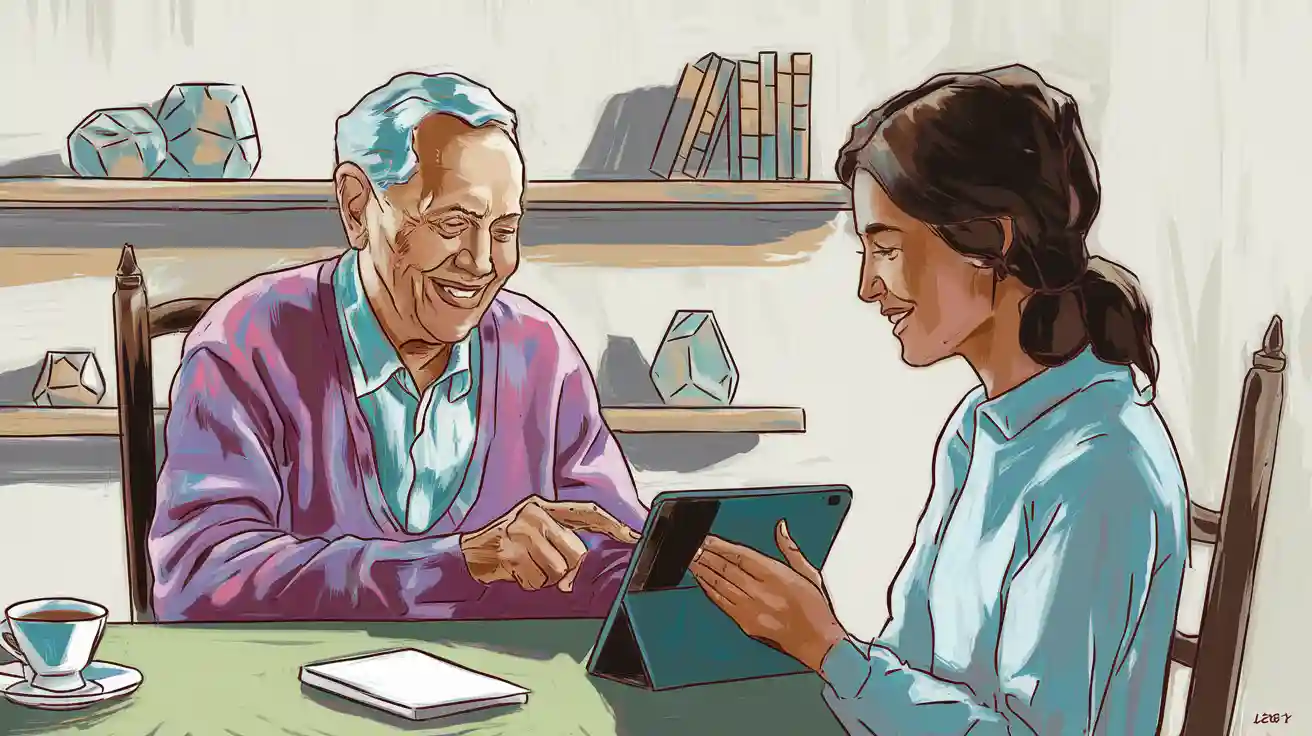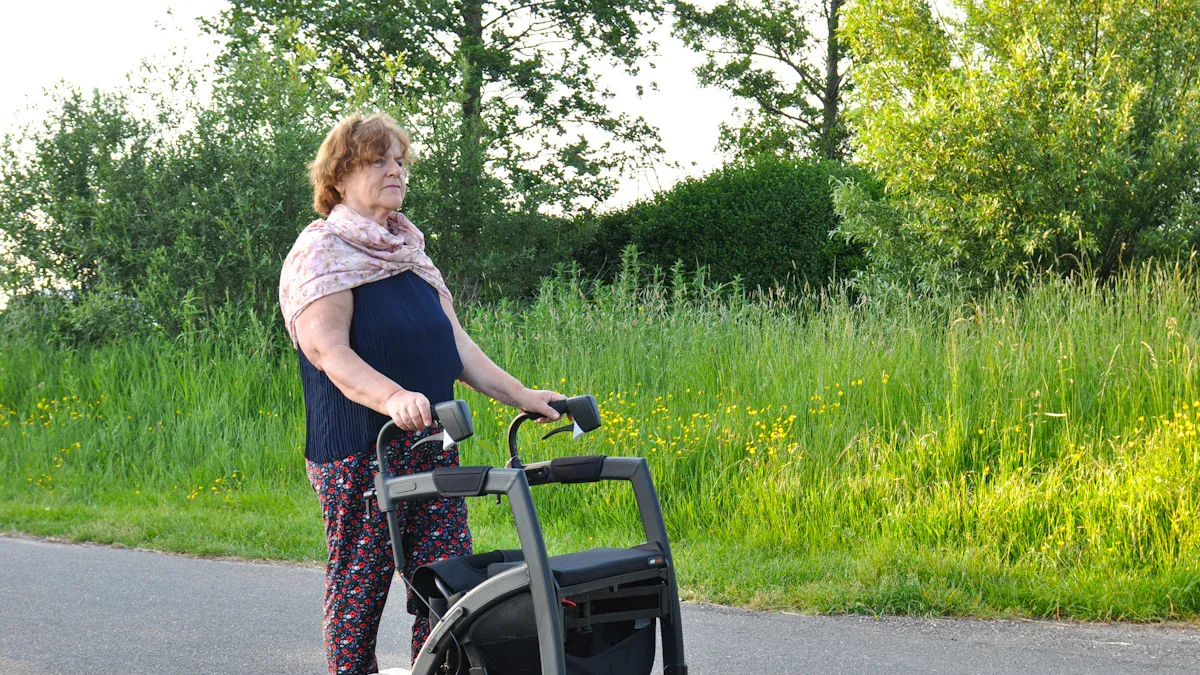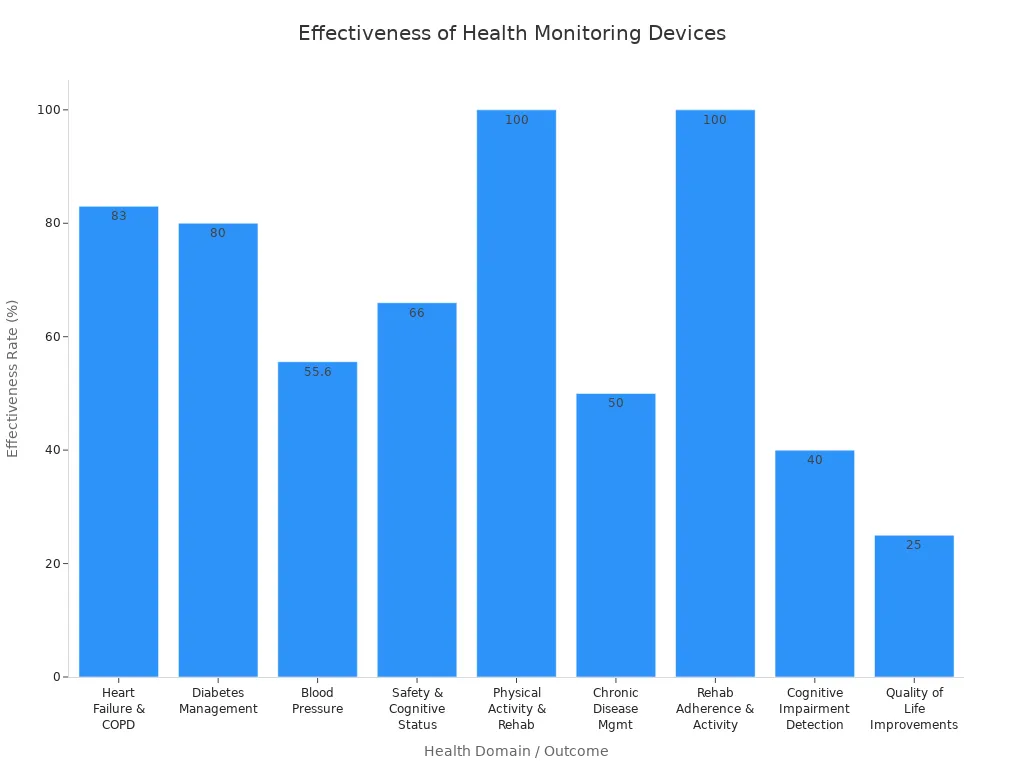Empowering Older Adults with Technology Support Services

You may see that many seniors like using technology to keep in touch with family and friends. For older people, learning new technology can help them live on their own. It can also make them feel more sure of themselves. Many times, children or friends help as tech support. This makes it easier and more fun to connect. Tech for Seniors programs show that seniors can learn new skills at any age. When you try something new, you can feel proud. You may also feel like you have more control.
Key Takeaways
Learning new technology lets seniors feel more independent. It also helps them feel more confident each day. Using devices and apps helps seniors talk to family and friends. This can make them feel less lonely. Technology support services give easy help with setting up devices. They also help you learn at your own speed. Assistive tools like health monitors and safety devices help seniors stay safe. These tools also help them stay healthy at home. Staying safe online is important. Use strong passwords and ask for help to avoid scams.
Tech for Seniors
Independence and Confidence
It is normal to feel worried about new technology. Tech for seniors can help you feel braver each day. Many older people learn to use a smartphone or tablet. This helps them feel in control. You can set reminders, check the weather, or read news. These small things help you become more independent.
Studies say that if you feel sure and excited, you will use technology more.
Family and friends can help you. This makes learning easier and more fun.
Many seniors show that older people can learn new tech. You can learn it, too!
Tip: Pick one easy device or app to start. Be happy for every new skill you get.
Staying Connected
Tech for seniors helps you talk to loved ones. You can use video calls, chat apps, or join online groups. These tools help you stay close to family and friends, even if they are far away.
A new study found that using Facebook, Zoom, and chat apps helps seniors feel less lonely. You may see that these apps make you happier and help you enjoy hobbies. Community classes can help you learn and feel more sure.
Staying connected is not just talking. It is also sharing photos, joining group chats, and being part of special times. You can enjoy these moments every day.
Safety at Home
Home safety is important for everyone, but it matters a lot for seniors. Tech for seniors gives you many tools to feel safe at home. Safety and emergency response devices, like alarms and medicine dispensers, help you feel calm.
Research shows these devices help seniors feel safer and help families worry less.
Home safety tools, like stove guards and GPS trackers, help you live on your own.
Safety and emergency response devices work best when you know how to use them and get help from caregivers.
Note: If you do not know how to use a device, ask for help. You should always feel safe and sure at home.
Technology Support Services for Seniors
Technology support services for seniors can help make life better. You do not have to do everything by yourself. Many people and programs want to help you use devices, apps, and online platforms for seniors. These services can help you set up your devices, learn new things, and get help when you need it. Let’s see how these technology support services can help you.
Device Setup and Troubleshooting
Starting with a new device can be hard. You might not know how to turn it on or use the touchscreen. Many seniors have these same problems. Sometimes, you may forget passwords or have trouble with updates. Small text on the screen can also be hard to read. Technology support services for seniors can help you step by step.
You can get help with:
Connecting to the internet and handling passwords.
Setting up email, social media, and video calling apps.
Updating software and keeping your device safe.
Changing settings for vision or hearing needs.
Tip: If you feel lost, ask for simple steps or written guides. Many technology support services have printed manuals or easy videos.
Some programs, like Senior Planet and Candoo, send helpers to your home or talk to you by phone. They can show you how to use smart home devices or set up reminders for medicine. They can also help you install safety tools like smart locks and emergency buttons. These assistive devices can help you feel safe and independent.
Personalized Training
Learning new technology is easier when it fits your style. Many seniors like one-on-one lessons or small group classes. Technology support services for seniors often offer both. You can pick what works best for you.
You might like:
Hands-on practice with your own device.
Taking notes or using printed instructions.
Learning at your own speed, with time to ask questions.
Some seniors like to learn from family or friends. Others like working with a teacher or joining a class. Programs like Cyber-Seniors and Senior Planet have friendly teachers who understand your needs. They know you may need more time or want to repeat steps. They also help you focus on what matters most, like staying safe online or using video calls to talk to loved ones.
Note: You can always ask for training that matches what you want to learn. If you want to learn about assistive technology, like voice assistants or smart home tools, tell your trainer.
Ongoing Tech Help
You may need help more than once. Technology changes quickly, and new questions can come up anytime. Technology support services for seniors are there for you, even after your first lesson. Some people call for help a lot, while others only need help sometimes.
Here’s a quick look at how seniors use ongoing tech help:
User Type | How Often You Might Ask for Help | Who You Might Ask For Support |
|---|---|---|
Often | Tech support, family, or friends | |
New User | Rarely | Family, friends, or social staff |
Infrequent/Non-User | Very rarely | Usually do not seek support |
You can ask technology support services for help with problems, learning new things, or just feeling more sure. Many services have phone lines, home visits, or online chat. Some even have special programs for assistive devices, like medical alert systems or smart speakers.
Common types of technology support services include:
Telehealth and remote monitoring for health needs.
Assistive devices and smart home systems for safety.
Artificial intelligence tools, like chatbots or virtual companions.
Daily living aids, such as medication reminders and smart kitchen tools.
Social and emotional support, like video calling devices and robotic pets.
Tech education programs, such as Senior Planet, Cyber-Seniors, and Candoo.
Remember: You are not alone. Technology support services for seniors are ready to help you every step of the way. You can keep learning, stay safe, and enjoy all the good things assistive technology can bring.
Assistive Technology for the Elderly

Health Monitoring Devices
You can use health monitoring tools every day. These tools help you check your health. Many elderly people wear smartwatches or fitness trackers. These devices track your heart rate, steps, and sleep. They help you and your family see health changes early. Some tools send alerts if your blood pressure or blood sugar is too high or low. This means you can get help quickly and avoid bigger problems.
Take a look at how these tools help in different health areas:
Health Domain / Outcome | Effectiveness Rate / Notes |
|---|---|
Heart Failure & COPD | 57% reduced exacerbations; 83% reduced hospitalizations |
Diabetes Management | 80% positive outcomes in broader studies |
Blood Pressure | 55.6% positive outcomes |
Physical Activity & Rehabilitation | 100% positive in rehab studies |
Quality of Life Improvements | 25% positive for quality of life |

These health monitoring tools give you more control. They help you feel calm and safe. They also help you stay independent, which is a big benefit.
Memory and Medication Aids
Do you forget to take your medicine sometimes? You are not the only one. Many elderly people use assistive technology for the elderly. These include electronic pill dispensers and reminder apps. These aids beep, flash, or talk to remind you about your pills. You can also use sticky notes, alarms, or put your medicine where you see it.
Using more than one reminder works best. For example, you can set an alarm and use a pillbox. This helps you remember, even if your day changes. When you feel sure about your memory, you may not need as many reminders. Still, these tools help you stay healthy and safe.
Tip: Try using both sound and visual reminders. This makes it easier to remember your medicine and enjoy the benefits of assistive devices.
Fall Detection and Safety Tools
Falls are a big worry for many elderly people. Fall detection systems help you get help fast if you fall. These devices sense a fall and send an alert to family or emergency services. Some work even if you cannot press a button.
Here are some important facts about fall detection systems and safety tools:
Statistic | Impact on Seniors |
|---|---|
Faster help reduces severe injuries, complications, and fatalities | |
80% of emergency responders report improved outcomes | Faster response and better care improve recovery chances |
80% of seniors feel safer and more independent | Psychological benefits reduce fear and promote mobility |
Seniors with fall detection systems are 50% more likely to get immediate help | Automatic alerts ensure help even if you are unconscious |
You can also use grab bars, non-slip mats, and smart home devices to make your home safer. Many fall detection systems work with other accessibility tools, like voice assistants and screen readers. These features make life easier for the elderly.
Note: Using assistive technology for the elderly, like fall detection systems, helps you stay active and worry less about accidents.
Choosing Senior-Friendly Technology
Assessing Needs
Picking the right device starts with knowing what you want. Maybe you want to talk to family, feel safe, or play games. Think about what is most important to you. Some people worry about mistakes or privacy. Others care about safety or having company. Your past with technology and your home can change what you pick.
Ask yourself:
What do I want this device to do?
Do I need help with health, safety, or talking to others?
Did someone I know suggest something that works for them?
What problems have I had with technology before?
When you answer these, you can find senior-friendly technology that fits your life.
Ease of Use
You want technology that is easy and feels good to use. Devices with big buttons and clear screens are easier to see. Small text or tiny buttons are hard to use. Look for devices that let you use your voice or touch.
Features that make technology easier:
Big letters and large icons
Bright screens with strong colors
You can type or talk to it
Simple menus and easy steps
If you like looking at photos or chatting, pick senior-friendly technology that makes it simple. A device that feels good in your hand and works fast will help you feel sure.
Tip: Try a device in the store or ask for a demo. You will know fast if it feels right for you.
Accessibility Features
Modern devices have many tools to help you use them. You can find things like TalkBack for spoken words, Voice Access for hands-free use, and Live Caption for videos. You can change font size and colors to make it easier for you.
Phones with big, bright screens and simple menus help you see and hear better. Voice assistants like Siri or Google Assistant can help you use your device. Some phones have picture dialing or GPS tracking for extra safety.
Here’s a quick look at helpful features:
Feature | How It Helps You |
|---|---|
Large, bright screen | Easier to read and see |
Big buttons and backlit keypads | Simple to press, even in low light |
Voice commands | Hands-free calls and texts |
Screen readers | Spoken feedback for low vision |
Emergency SOS | Quick help in an emergency |
Customizable settings | Make the device fit your needs |
Senior-friendly technology with these features can help you stay safe and independent every day.
Technology That Helps Seniors
Daily Living Tools
There are many daily living tools you can use. These tools help you stay safe and do things on your own. Many elderly people use assistive devices every day. You might use a grab bar in the bathroom. Some people use a walker to move around. Large-button phones and pill organizers are also helpful. These tools make life easier for seniors. They help you live at home longer. Look at this table to see some popular choices:
Category | Examples of Tools | Purpose/Benefit |
|---|---|---|
Bathroom Aids | Grab bars, shower chairs | Prevent falls, add stability |
Mobility Aids | Walkers, canes, scooters | Support walking and balance |
Communication Aids | Large-button phones, tablets, hearing aids | Improve communication |
Self-Care Aids | Raised toilet seats, dressing sticks | Make personal care safer and easier |
Kitchen Aids | Adaptive utensils, electric can openers | Help with meal prep and eating |
Medication Aids | Pill organizers, medication reminders, dispensers | Remind and organize medication intake |
These assistive tools can make your home safer. They also make daily tasks easier. Many elderly people feel more confident using these devices.
Social and Communication Apps
It is important to stay connected with others. Social and communication apps help you talk to family and friends. You can use them even if your loved ones live far away. Many seniors use video calls and chat apps. Online groups are also popular. These apps can help you feel less lonely. They can also make you happier. Here are some ways these apps help:
Video calls let you see and talk to loved ones.
Group chats help you join family events and talk often.
WhatsApp and Facebook make it easy to send photos and messages.
Simple designs and training help you use new technology.
Many elderly people feel less alone when they use these apps.
If you feel unsure, you can ask for help. Family, caregivers, or tech support can show you how to use these apps. Using social apps helps you build stronger bonds. You also get more support from others.
Health and Wellness Solutions
Technology can help seniors stay healthy and active. Many elderly people use telehealth platforms to talk to doctors. You can book appointments and get advice from home. Telehealth is becoming more common. You can also track your medicine and check your health stats.
Fitness apps and online classes help you stay active. You can join chair yoga, Tai Chi, or walking groups online. Many seniors say they have better balance and less stress after joining these programs. Nutrition apps and meal delivery services help you eat healthy foods.
Assistive technology helps you feel better in many ways. You can use medication reminders and health tracking apps. Smart devices help you manage your care. Telehealth makes it easier to see a doctor and stay at home. Many elderly people feel more independent and in control with these solutions.
Tip: Try one new assistive tool or telehealth platform at a time. You might find it helps you enjoy life and stay connected.
Getting Started with Tech Support
Step-by-Step Guides
You might feel unsure when you try something new, but step-by-step guides can make things much easier. These guides break down each task into small, simple steps. You can follow along at your own pace. Many technology support services create guides with big letters and pictures, so you can see what to do next. Here’s a helpful way to get started:
Begin with a simple device that feels comfortable.
Ask for one-on-one help that matches your interests.
Use guides with clear words and lots of pictures.
Practice often and set small goals.
Connect new skills to your favorite hobbies.
Join a group or class for extra support.
Learn about online safety to protect yourself.
Tip: Keep your guides close by. You can look at them anytime you need a reminder.
Hands-On Training
You learn best when you try things yourself. Hands-on training lets you touch, tap, and explore your device. Many technology support services offer patient teaching, so you never feel rushed. You can ask questions and repeat steps as often as you want. Some programs, like Senior Planet and GetSetUp, have friendly teachers who show you how to use apps, send messages, or join video calls. They help you practice until you feel sure.
Try these ideas for hands-on learning:
Use your own device during lessons.
Write down steps in big letters.
Practice with a friend or in a small group.
Celebrate each new skill you learn.
Finding Reliable Help
You want to find support you can trust. Many national and local resources offer technology support services just for seniors. Here are some trusted options:
Resource Name | What They Offer |
|---|---|
GetSetUp | Live classes and workshops for seniors |
Senior Planet (OATS) | Courses, activities, and tech support |
Senior Neighbors Tech Support | One-on-one help and device access |
AGING Connected | Low-cost internet and support |
Making IT Easier Series | Video lessons for daily tech tasks |
You can also use trusted health websites like Mayo Clinic or WebMD for safe information. YouTube has easy-to-follow videos for many tech topics. Always look for support from programs that understand your needs and offer clear, patient help.
Note: Good technology support services will answer your questions, help you feel confident, and make learning fun.
Online Safety for Seniors

Staying safe online matters just as much as staying safe at home. You can enjoy all the benefits of assistive technology, telehealth, and online support when you know how to protect yourself. Let’s look at some easy ways to keep your information safe, avoid scams, and communicate with confidence.
Protecting Information
You share a lot of personal details online, from your name to your health records. It’s important to keep this information private. Here are some simple steps you can follow:
Use strong passwords with letters, numbers, and symbols. Try a password manager if you have trouble remembering them.
Update your devices and assistive apps often. This keeps your support tools secure.
Never share your Social Security number or banking details by email or social media.
Avoid clicking on links or opening attachments from people you don’t know.
Use antivirus software and keep it up to date for extra support.
Only use telehealth services from trusted providers.
Tip: If you get a message that feels urgent or strange, take a moment to check with a family member or your tech support before you respond.
Avoiding Scams
Scammers target seniors because they trust easily and may not know all the tricks. You can spot most scams if you know what to look for. Here are some common scams and how to avoid them:
Phishing scams: Fake emails or texts ask for your information. Don’t click on links or give out details.
Tech support scams: Someone calls or pops up on your screen, saying your device has a problem. Real support never asks for payment or remote access out of the blue.
Social media scams: Fake profiles or ads try to get your money or personal info. Check privacy settings and be careful with new contacts.
Healthcare scams: Someone claims to be from Medicare or a health plan. Always call the real company to check.
Scam Type | What To Do |
|---|---|
Verify the caller’s identity before sending money | |
Shopping | Buy only from trusted websites |
Lottery/Sweepstakes | Never pay to claim a prize |
If you feel unsure, ask for assistive support from a trusted friend or caregiver. Report scams to the FTC or your local support agency.
Safe Communication
You want to connect with others, but you also want to stay safe. Here’s how you can use assistive tools and support to protect yourself:
Be careful with messages that seem too good to be true.
Don’t download apps or software unless you know they are safe.
Use video calls or telehealth platforms with strong privacy settings.
Set up assistive features like call blocking and spam filters for extra support.
If someone asks for money or personal details, stop and check with your support network.
Note: You can always ask for help from your tech support team or use assistive resources online. Many local libraries and senior centers offer digital safety classes to help you feel more confident.
Staying safe online lets you enjoy all the benefits of assistive technology, telehealth, and support services. You can connect, learn, and live well without the worry of a scam or a fall for fake offers.
You can live safer and do more on your own with technology support services. Devices like video calling tools, health monitors, and voice assistants help you talk to others and handle daily jobs. Many seniors pick up new skills, show others what they know, and feel braver each day.
Robotic pets and brain games help you feel happier and remember things better.
Telehealth and reminders for medicine help you stay healthy.
Fun classes and kind helpers make learning simple.
You can begin at any age. Try something new and see how technology can make your life better.
FAQ
How do I find technology support services near me?
You can ask at your library or senior center. Many places give free tech help. You can also look online for Senior Planet or Cyber-Seniors. These programs might be close to you.
What if I forget how to use my device?
It is okay if you forget. Keep a printed guide or sticky notes nearby. You can call tech support or ask family for help. The more you practice, the easier it gets.
Are technology support services expensive?
Many services do not cost much or are free. Some, like Senior Planet, have free classes. You can also find free videos and guides online. Always ask about the price before you join.
How can I stay safe while using technology?
Make strong passwords and do not share personal info with strangers.
Update your devices often to keep them safe.
If something seems strange, ask someone you trust before you click or share.
What devices are easiest for seniors to use?
Device Type | Why It’s Easy |
|---|---|
Tablets | Big screens, touch controls |
Simple cell phones | Large buttons, loud sound |
Smart speakers | Voice commands, no screen |
Pick the device that feels best for you!
See Also
Ways Artificial Intelligence Will Boost Your Growth In 2025
Top Five Benefits Of Completing AI Readiness Tests In 2025
The Role Of AI Agents In Advancing Career Development
Essential Generative AI Prompting Advice For New Users In 2025